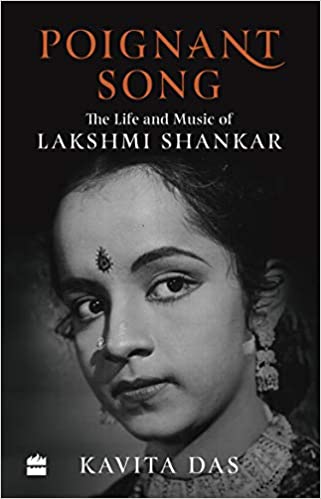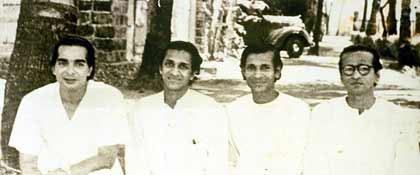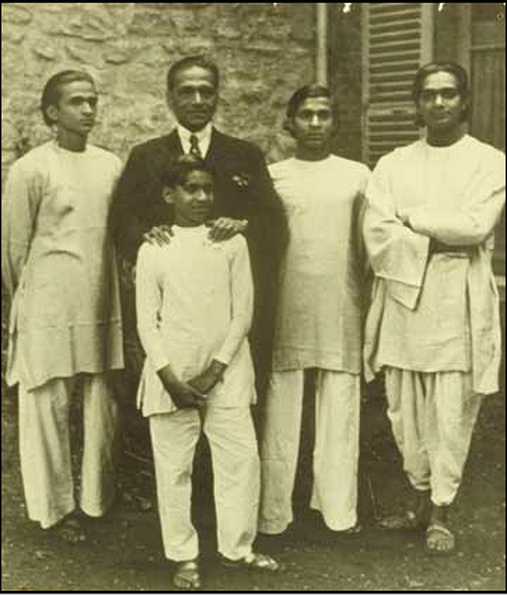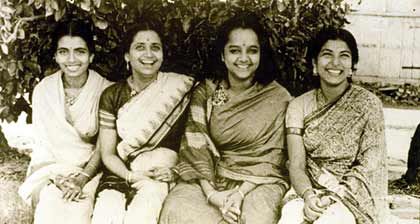This is the second in my series on forgotten musicians. It is on the life and music of Lakshmi Shankar, who was married to Rajendra Shankar, one of the Shankar brothers.
Let me start with a caveat: by “forgotten”, I do not mean that they have been completely erased from the memories of connoisseurs. What I mean is that they did not receive the recognition that was due to them in their life time, and maybe largely because of this, they are not remembered by as many genuine lovers of Indian music, as they deserve to be. It could also be because they lived in a generation packed with such great stalwarts that they got side lined. Another criterion for being included here is that I keep going back to their music once in a while. When you check the posts on their music in the public domain, the views are at most in three digits, and number of comments in single or two digits. I hope that my posts will make these musicians better known and encourage people who might be sitting on their old recordings to share them in the public domain.
In my first post in this series, I had mentioned attending a concert series at a temple festival, as a child. This was in the late 1960s, in Ambalamedu, near Kochi. One of those who performed there was Lakshmi Shankar who sang her bhajans. Like all other concerts at the festival, this one also got recorded on our Grundig spool tape recorder. For years thereafter, it used to be played often at home until my father passed away in 1988. It now lies somewhere at my mom’s last home in Kochi. K.K. Kamath, old time family friend from my mother’s hometown of Alappuzha/Alleppey, who as Chief Engineer had worked with my dad, was a connoisseur and amateur singer in both Hindustani and Carnatic. He knew people who were in touch with Lakshmi Shankar. He informed one day that Lakshmi Shankar remembered her Ambalamedu concert as one of her best performances, and that she wanted a copy of the recording. I don’t know whether we managed to copy and send it to her, as by then spool recorders were out of fashion, having been bested by the more convenient cassette players.

As I was writing this post and researching for it, I was pleasantly surprised to learn that there was a recent biography of Lakshmi Shankar written by Kavita Das (Poignant Song: The Life and Music of Lakshmi Shankar, Harper Collins, 2019). The find was quite timely as it helped me fill in some details.
Lakshmi Shankar (1926-2013) was born in Jamshedpur, where her father R. Vaidyanath Sastri was working as a Controller of Accounts with Tata Steel. He hailed from Thirukokarnam, a village in Pudukottai District, south of Tiruchirapalli and Thanjavur districts. Pudukottai was then a native state encircled by the erstwhile Madras Presidency. Her mother, Visalakshi, came from Palakkad, then a part the Malabar District of the Madras Presidency.
Her father, influenced by Gandhi, left the job with Tata Steel, to join him and also for some time edited the Harijan magazine, prompting Gandhi to give him the name “Harijan Sastry”. Not happy with the politics in the independence movement, Sastry left Pune to come to Madras. In Madras, the young Lakshmi studied in St. Thomas Convent School, and learnt her first lessons in Bharatanatyam at the age of eight under Guru Kandappan Pillai of Kancheepuram, who had also taught the legendary Balasaraswati. At the age of 12, she had her arangetram (first performance) at Rukmini Devi’s Kalakshetra.
Watching Uday Shankar at one of his performances in Madras, where he appeared in diverse roles, first as Indra, then as a snake charmer, and then again as Bhasmasura, each more convincing than the earlier. He was already world famous, prompting James Joyce to remark, “He moves on the stage like a semi-divine being. Believe me, there are still some beautiful things left in this world,” It was her Guru, Kandappan Pillai, who informed that Uday Shankar was auditioning for teachers and dancers for his new Uday Shankar India Cultural Centre in Almora. So, iIn 1940, at the age of 13, and accompanied by her mother and sister, went to Almora to join the Centre. Her brother stayed back to study in Chidambaram, and her father, who disliked Madras, moved to Calcutta, where he took up a new job.

In Almora, Lakshmi was introduced to Hindusthani music for the first time. She also got exposed to dance forms other than Bharatanatyam. This included Kathakali, which was taught by Sankaran Namboodiri, who was also a guru to Uday Shankar himself. Kathakali, along with other dance forms, was to inspire dance movements in many of Uday Shankar’s productions. The music department was headed by another legend, Ustad Allauddin Khan, a master of numerous instruments, who taught sitar to Ravi Shankar, Uday’s youngest brother, sarod to Ali Akbar Khan, surbahar to his daughter Annapurna Devi, and flute to Pannalal Ghosh.

Apart from Uday and Ravi, the eldest and youngest, the other two Shankar brothers were also in Almora. Debendra, the third, also learnt dance. Rajendra, the second brother, was studying Physics and Chemistry. He was to go for a PhD in England if he followed the wishes of their father, Shyam Shankar Chowdhury, a lawyer. But, Uday managed to get him to Almora to help in managing the Centre. It was there that he proposed to Lakshmi, then 15 years of age, and 21 years his junior, through Zohra (later Sehgal) and her mother. They finally got married in a very simple function for which their father came from Calcutta. Lakshmi’s mother returned with her other daughter and husband. With the onset of the War, the Centre had to close down. Rajendra Shankar and Lakshmi Shankar moved to Bombay via Ahmedabad. She would later switch from dancing to singing Hindusthani music, mostly bhajans, dadra, and thumri.

Shankar bahus: Annapurna Ravi Shankar, Krishna Debendra Shankar, Lakshmi Rajendra Shankar, Amala Uday Shankar in 1947
Lakshmi Shankar had sung for quite a few movies, Aandhiyan (1952), Do Boond Pani (1972) and Aarop (1974). But, her most famous rendition was for Richard Attenborough’s Gandhi, whose music director was Pt. Ravi Shankar. M.S. Subbulakshmi was the initial choice, but Ravi Shankar felt that she may not adjust to his style. But, there were critics who felt that he had opted for Lakshmi Shankar, because she was his sister-in-law. According to Kavita Das, her biographer, Ravi Shankar chose her because they had worked together on many other projects earlier, including choreographing and dancing in his ballet, Discovery of India, inspired by Nehru’s eponymous book. She was also the lead vocalist for his musical production, Melody and Rhythm, and his Festival from India international tour. Their most famous collaboration was in the famous Beatle, George Harrison’s production, “I am missing you”, a Hindustani pop song written in English by Ravi Shankar, sung by Lakshmi Shankar (see here and here), and performed in Harrison’s Dark Horse tour.
As the titles start to roll in the film Gandhi, Lakshmi Shankar’s voice is heard singing Gandhi’s favourite bhajan, “Vaishnav Janto…”. A little later, we hear Asit Desai singing “Raghupati Raghav Rajaram…” and Lakshmi Shankar joins from the second stanza. In the last ten seconds of the film, as the credits draw to an end, Lakshmi Shankar once again sings “Raghupati Raghav Rajaram…” for one last time.
Her daughter, Viji, was married to L. Subramaniam, the violinist, and died early.
Keri Lynn Engel writes in this post, of Lakshmi Shankar, as follows: “…magic of her rich, melodious voice, her sense of proportion and the emotional content of her singing are some of the qualities that have made her one of the foremost and most popular vocalists since the last fifty years.”
Lakshmi Shankar passed away in 2013.
For more on her life, suggest reading the book, which I have not completed as yet.
Some links to her music
Jayadev’s Ehi Murare Kunjavihare taken from his Gita Govinda –
Surdas bhajan, Hey Govinda, Hey Gopala
Music Today collection of thumri and dadra More of bhajans here and related links (seven songs in the series, Songs of Devotion).
Barsan Lagi and other songs from Music Today’s Song of the Seasons, Volume 3.
Happy listening!
![]()